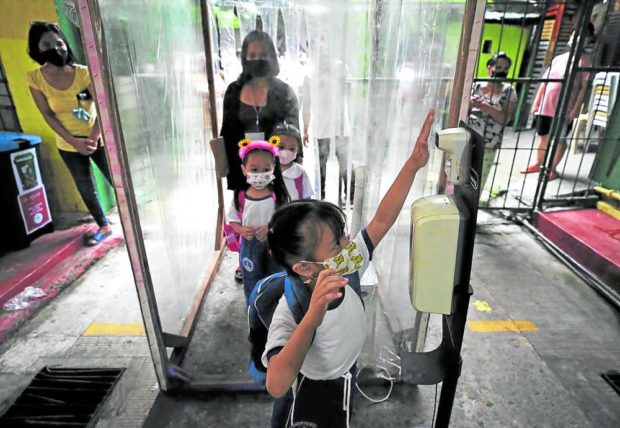
SCHOOL’S BACK | Students pass through a booth for disinfection and temperature check at Aurora Quezon Elementary School in San Andres, Manila, during the first day of limited in-person classes in August. (File photo by RICHARD A. REYES / Philippine Daily Inquirer)
MANILA, Philippines — No COVID-19 clusters had been detected in schools since limited in-person classes resumed in August, indicating that infections were not being spread in schools, according to health authorities.
COVID-19 clusters refer to concentrations of confirmed cases that are linked by their exposure to the virus in the same area at the same time.
The Department of Health (DOH) said vaccination had been key to preventing outbreaks in schools, along with wearing of masks and good ventilation.
They urged parents and guardians to have their children vaccinated and boosted before full in-person classes start in November.
“Right now, I am not aware of reports of clusters coming in from schools. Hopefully, that indicates we’ve been able to manage this pretty well,” said pediatric infectious disease specialist Dr. Anna Ong-Lim, who has been advising the DOH since the pandemic broke out in March 2020.
“We’re on the lookout for such reports because that will show there is transmission within the school context,” she added in an online briefing arranged by the DOH on Monday.
Vaccination coverage
Dr. Edsel Salvana, another infectious disease expert who also sits in the DOH technical advisory group on COVID-19, said that with the resumption of full in-person classes, “there will be infections but what minimizes that is vaccination, booster shots, masking, and ventilation.”
“We aren’t aiming for 100 percent prevention, otherwise we would not reopen [schools],” he added.
DOH chief epidemiologist Dr. Alethea de Guzman said schools had been briefed about case surveillance and coordination mechanisms with the health offices of local governments.
“We advocate for vaccination at the same time we do monitoring in schools. We are looking for clusters of cases or unusually high numbers of absences,” she said.
Ong-Lim said she was “worried” about the upcoming full resumption of in-person classes because the vaccination coverage among children 5 to 11 years old was not high enough—currently around 47 percent.
Among the 12 to 17 years old, over 100 percent have received their primary series of doses, but only 11 percent have been given booster shots to strengthen their immunity.
Children below 5 years old are ineligible for vaccination.
Case update
Daily reported cases have lately remained steady at an average of around 2,000 per day, with no signs of a significant decline, according to the DOH.
The latest weekly case bulletin showed an average 2,048 new cases were confirmed through laboratory tests from Oct. 3 to 9, which is 10 percent lower than the previous week’s 2,288.
Five additional severe and critical cases were admitted last week, bringing the total such cases to 669. The DOH said there had been no decline in the number of severe and critical cases in recent weeks.
COVID-19 deaths also continued to climb as 256 more deaths were confirmed by the DOH, some from as far back as a year ago.
The country’s COVID-19 death toll is 63,297 out of 3.96 million confirmed cases.
Most of the 26,014 active cases are not admitted to hospitals. The DOH reported that 614 or 24.3 percent of intensive care unit (ICU) beds for COVID-19 patients are occupied, while 5,730 or 27.3 percent of non-ICU beds allotted are in use.
Cases in Metro Manila, where most tests are conducted, are “currently showing signs of plateauing,” while cases in the nearby provinces of Bulacan, Cavite, Laguna, and Rizal are on an “upward trend,” according to the DOH.
Mindanao shows an “incremental increase in cases” while cases in the rest of Luzon and the Visayas are basically unchanged.
RELATED STORIES
COVID-19 outbreaks unavoidable during face-to-face classes — OCTA
OCTA fellow: In-person classes could have caused NCR COVID-19 positivity rate uptick
CHEd lifts COVID-19 vax requirement for face-to-face classes